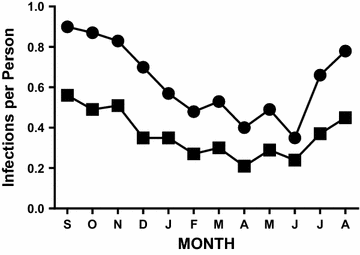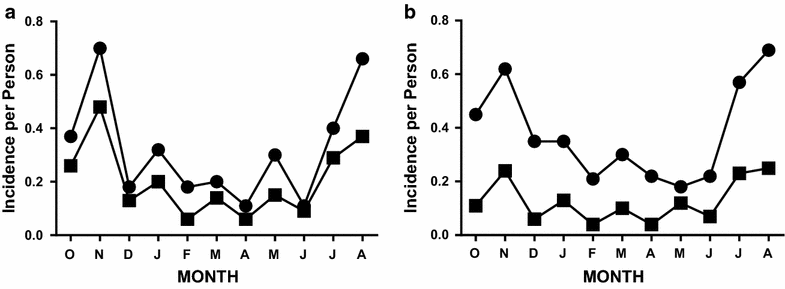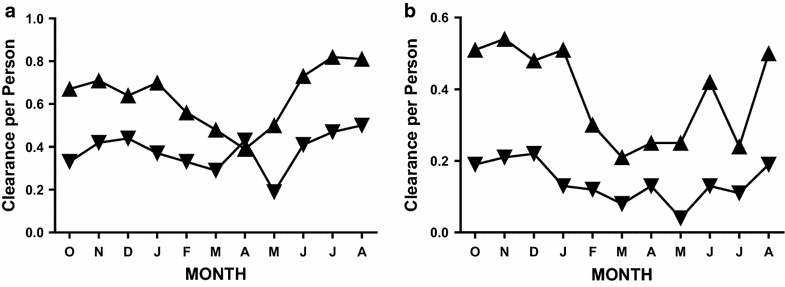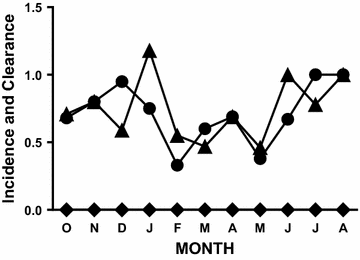Molecular incidence and clearance of Plasmodium falciparum infection
- PMID: 26492968
- PMCID: PMC4618950
- DOI: 10.1186/s12936-015-0941-7
Molecular incidence and clearance of Plasmodium falciparum infection
Abstract
Background: Although the epidemiology of malaria has been based primarily on microscopy and rapid diagnostic tests, molecular methods are necessary to understand the complexity of natural infection in regions where transmission is intense and simultaneous infection with multiple parasite genotypes is common such as sub-Saharan Africa.
Methods: To compare microscopic and molecular estimates of the incidence and clearance of Plasmodium falciparum infection, we followed 80 children monthly for 1 year in the village of Bancoumana in Mali.
Results and discussion: Similar seasonal patterns were observed with both methods (rainy season peak, dry season nadir), although molecular methods detected more infections than microscopy (571 vs 331 in 906 specimens), more new infections (311 vs 104 during 829 person-months) and spontaneous clearance events (317 vs 116) and found higher incidence (0.38 vs 0.13 new genotypes/person/month, p < 0.001) and spontaneous clearance rates (0.38 vs 0.14 genotypes cleared/person/month, p < 0.001). These differences were greatest for persistently-infected subjects in whom neither new infections nor the clearance of old infections could be detected by microscopy (0.71 new infections and 0.73 cleared infections per month using molecular methods vs 0.000 by microscopy, p < 0.001).
Conclusions: Molecular methods provide information about genetic diversity, the intensity of transmission and spontaneous clearance in the absence of drug treatment that cannot be obtained by microscopy. They will be necessary to evaluate the efficacy of vaccines, drugs and other control strategies for diseases such as malaria in which simultaneous infection with more than one organism (genotype) is common.
Figures




Similar articles
-
Comparison of detection methods to estimate asexual Plasmodium falciparum parasite prevalence and gametocyte carriage in a community survey in Tanzania.Malar J. 2014 Nov 18;13:433. doi: 10.1186/1475-2875-13-433. Malar J. 2014. PMID: 25404207 Free PMC article.
-
Plasmodium falciparum parasite infection prevalence from a household survey in Zambia using microscopy and a rapid diagnostic test: implications for monitoring and evaluation.Acta Trop. 2009 Dec;112(3):277-82. doi: 10.1016/j.actatropica.2009.08.011. Epub 2009 Aug 13. Acta Trop. 2009. PMID: 19682968
-
Malaria prevalence defined by microscopy, antigen detection, DNA amplification and total nucleic acid amplification in a malaria-endemic region during the peak malaria transmission season.Trop Med Int Health. 2011 Jul;16(7):786-93. doi: 10.1111/j.1365-3156.2011.02773.x. Epub 2011 Mar 29. Trop Med Int Health. 2011. PMID: 21447064
-
Asymptomatic Multiclonal Plasmodium falciparum Infections Carried Through the Dry Season Predict Protection Against Subsequent Clinical Malaria.J Infect Dis. 2015 Aug 15;212(4):608-16. doi: 10.1093/infdis/jiv088. Epub 2015 Feb 23. J Infect Dis. 2015. PMID: 25712968 Free PMC article.
-
High prevalence of sub-microscopic infections in Colombia.Malar J. 2015 May 15;14:201. doi: 10.1186/s12936-015-0711-6. Malar J. 2015. PMID: 25971594 Free PMC article.
Cited by
-
Genetic diversity of Plasmodium falciparum in human malaria cases in Mali.Malar J. 2016 Jul 11;15:353. doi: 10.1186/s12936-016-1397-0. Malar J. 2016. PMID: 27401016 Free PMC article.
-
Seasonal variations in Plasmodium falciparum genetic diversity and multiplicity of infection in asymptomatic children living in southern Ghana.BMC Infect Dis. 2018 Aug 29;18(1):432. doi: 10.1186/s12879-018-3350-z. BMC Infect Dis. 2018. PMID: 30157794 Free PMC article.
-
The epidemiology of residual Plasmodium falciparum malaria transmission and infection burden in an African city with high coverage of multiple vector control measures.Malar J. 2016 May 23;15(1):288. doi: 10.1186/s12936-016-1340-4. Malar J. 2016. PMID: 27216734 Free PMC article.
References
-
- Kalin M, Lindberg AA, Tunevall GL. Etiological diagnosis of bacterial pneumonia by gram stain and quantitative culture of expectorates: leukocytes or alveolar macrophages as indicators of sample representativity. Scand J Infect Dis. 1983;15:153–160. doi: 10.3109/inf.1983.15.issue-2.05. - DOI - PubMed
Publication types
MeSH terms
Grants and funding
LinkOut - more resources
Full Text Sources
Other Literature Sources

